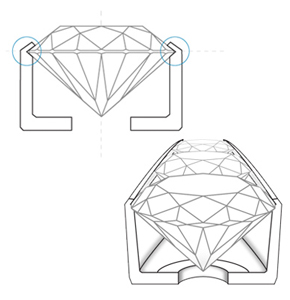Channel setting is a method whereby stones are suspended between two bars or strips of metal, called channels. Often when setting small stones and the bars go in a linear line with the design it is called channel setting, and when the bars cross the lines of the design, it is called bar set. The idea is the same, though. The channel is some variation of a "U" shape, with two sides and a bottom. The sides are made just a bit narrower than the width of the stone or stones to be set, and then, using the same burs as in prong setting, a small notch, which is again called a bearing, is cut into each wall. The stone is put in place in those notches, and the metal on top is pushed down, tightening the stone in place. The proper way to set a channel is to cut a notch for each stone, but for cheaper production work sometimes a groove is cut along each channel. Also, since the metal can be very stiff and strong, this is a situation where a reciprocating hammer, which is like a Jackhammer, but jewelry sized, might be used to hammer down the metal, as it can be difficult to do by hand. Then, as always, the metal is filed down and finished, and the inner edge near the stones cleaned up and straightened as necessary. As with all jewelry, there can be many variations of channel work. At times the walls will be raised—sometimes a center stone will be set between two bars that rise high from the base ring—or the channel might just be cut directly into some surface, making the stones flush with the metal. It is still channel setting, though
.
Channel Setting
Channel set

